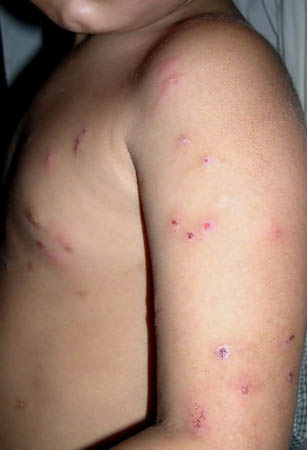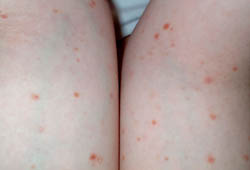Summary
Definition
History and exam
Key diagnostic factors
- acute to subacute recurrent skin eruption
- polymorphic, generalised, non-pruritic skin eruption
Other diagnostic factors
- scars or pigment changes
- immunosuppression
- recent illness
- family history of pityriasis lichenoides
- headache
- myalgias/arthralgias
- malaise
- burning/pruritus
- multi-organ failure
Diagnostic investigations
Investigations to consider
- anti-streptolysin titres
- Epstein-Barr virus IgM/IgG viral capsid antigen and nuclear antigen antibody
- monospot or heterophil antibody test
- hepatitis B surface antigen, anti-surface antibody, and anti-core IgM
- hepatitis C virus antibody
- HIV screening
- rapid plasma reagin
- throat cultures
- toxoplasma Sabin-Feldman's dye test, indirect immunofluorescence/haemagglutination
- erythrocyte sedimentation rate
- CRP
- serum LDH
- WBC count
- serum albumin
Treatment algorithm
Contributors
Authors
Amy Musiek, MD
Professor of Dermatology
Division of Dermatology
Washington University School of Medicine in St. Louis
St. Louis
MO
Disclosures
AM is a paid lecturer in cutaneous T-cell lymphoma for Dermatology Week, is the author of the UpToDate article on Pityriasis lichenoides chronica, and is an investigator for multiple industry sponsored studies all unrelated to pityriasis lichenoides.
Acknowledgements
Dr Amy Musiek would like to gratefully acknowledge Dr Amer Khachemoune and Dr Marianna Blyumin-Karasik, previous contributors to this topic.
Disclosures
AK and MB-K declare that they have no competing interests.
Peer reviewers
Andrew D. Lee, MD
Resident
Department of Dermatology
Wake Forest University School of Medicine
Winston-Salem
NC
Disclosures
ADL declares that he has no competing interests.
Abdulhafez Selim, MD
Assistant Professor
King Fahd University of Petroleum and Minerals
Dhahran
Saudi Arabia
Disclosures
AS declares that he has no competing interests.
Use of this content is subject to our disclaimer

